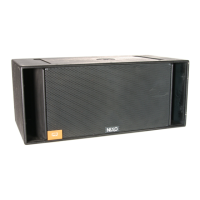PLEASE READ CAREFULLY BEFORE PROCEEDING
Page 4 / 76 System Manual RS Series
Going one step further in low frequency control: Ray Sub Technology
Radiation control of low frequencies is hard to achieve due to wavelength being larger than cabinet size. Consequently, most of
current subwoofers available on the audio-professional market are omnidirectional.
Drawbacks in using omnidirectional subwoofers are known by experienced engineers:
• Low Frequency sound pressure level is typically higher on stage than over the audience; high-pass filters are
mandatory in almost all microphones inputs to avoid feedback from the microphones to the subwoofers. Moreover,
gain from microphone to speakers is highly limited due to that feedback (reinforcing a double-bass can be an enormous
challenge)
• Indoor environments typically have much higher reverberation time in the Low Frequency range than in the mid and
high Frequencies. This characteristic is emphasized by the omnidirectional pattern of conventional subwoofers (all
sound engineers experienced kick drum lasting forever
• Many outdoor shows occur nearby residential areas where noise constraints are very restrictive; in such cases, low
frequencies levels over the audience have to be limited so that environment criteria are fulfilled (possibly leading to
unacceptable wideband limitations)
Gradient subwoofers provide an elegant solution to the above issues, based on a technology that is a simple transposition to
sound sources of what has been applied for decades in microphones: radiated field derives from pressure differences generated
from two (or more) sources:
• Rear radiation is lowered by more than 12 dB, which benefits to stage as well as to neighbours
• Direct to reverberant ratio is increased by nearly 6 dB in the low frequency range (which potentially gives back a kick
drum its original “punch”)
However, there are efficiency limitations: gain in lower bandwidth is reduced when sources become too close in relation to
wavelength, and pattern control is limited in upper bandwidth when both sources interfere destructively in the radiation axis.
Operating bandwidth were efficiency combines with pattern control is around 2 octaves.
Poor correlation between cabinet design and targeted specifications leads to two (and eventually more) drivers in directional
mode producing less energy than one driver in omnidirectional mode, which is not acceptable for simple practical aspects such
as weight and volume.
NEXO released its first gradient subwoofer, the CD12, which has been complemented since then by CD18, GEO SUB and
RS15. These have been quickly adopted worldwide as standards and are considered today as state-of-the-art subwoofers. This
success is a consequence of proper cabinet design and optimized definition of phase relations through sophisticated DSP
algorithms leading to high directional control and SPL output.
With RAY SUB patented technology, NEXO is again moving one step forward. RAY SUB technology is about optimizing
positioning and phase relationship of radiating surfaces in vented enclosures, so that acoustic distance from rear to front sections
always increases as frequency decreases; consequently, rear and front section always sum up efficiently – typically 5 dB gain
from rear section in the forward direction – and cancel in the rearward direction.
Used as a single cabinet, RAY SUB Technology allows the same cabinet to be configured for any polar pattern, omnidirectional
as a standard direct radiating subwoofer when speakers are facing the audience, or highly directional when cabinet is rotated
speakers sideways or upwards.
Used in arrays, RAY SUB subwoofers can be set back to back, front to front, in vertical columns, and beam-steered upwards or
downwards provided column length is sufficient.
NEXO RAY SUB technology brings a never achieved low frequency directional control to the sound reinforcement industry,
raising one more time NEXO standards.

